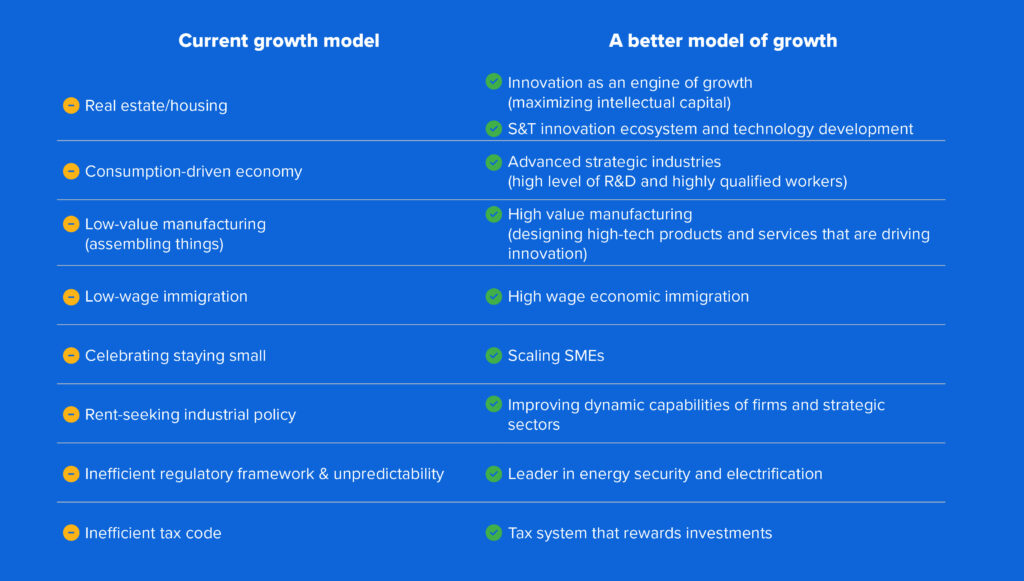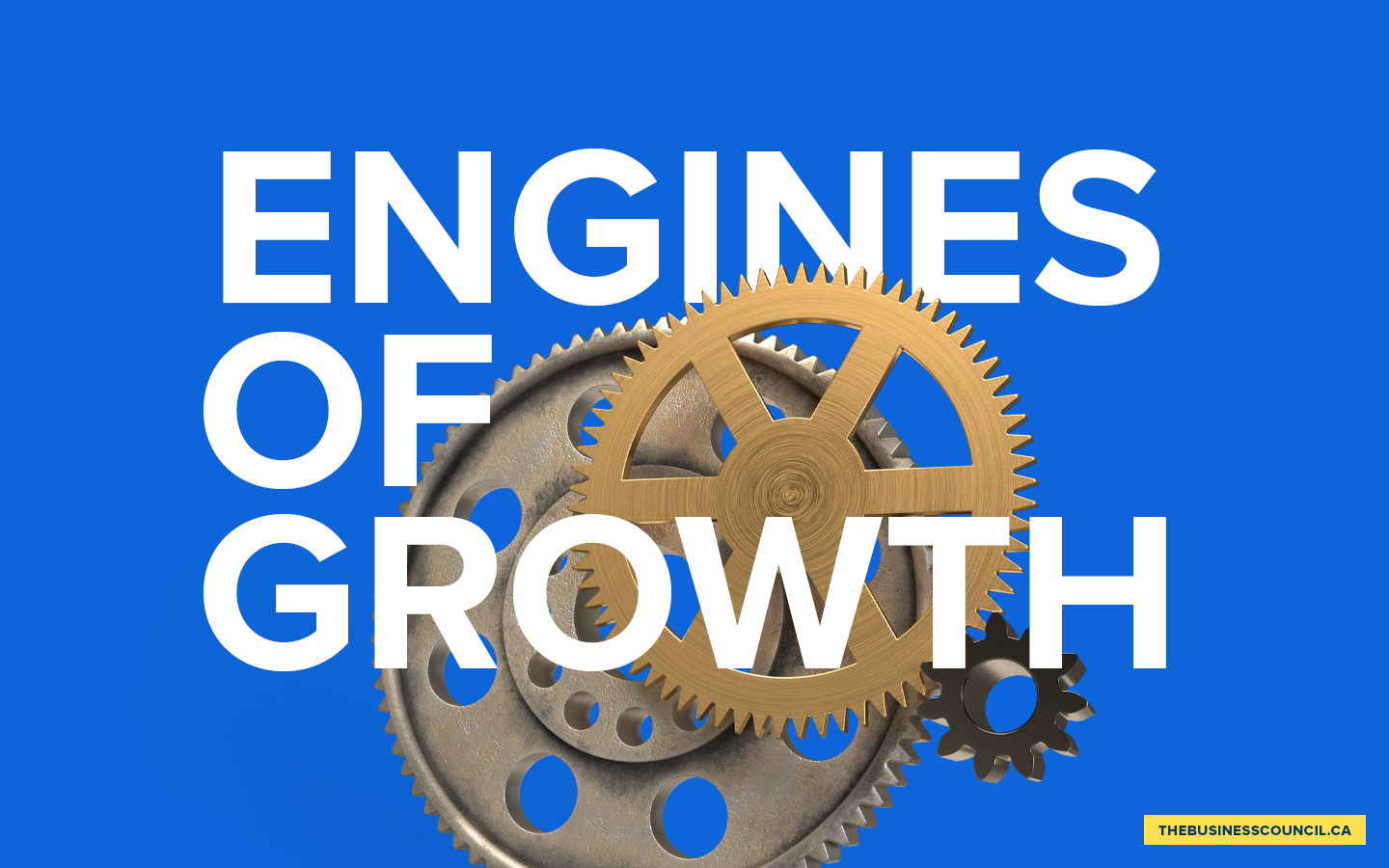Engines of growth
Introduction
Canada has consistently ranked among the world’s top countries for its high quality of life. Abundant resources, a highly educated population and strong international ties have all contributed to Canada’s enviable living standards.
However, progress has stalled.
Data from various sources, including Statistics Canada, the OECD and other economic research institutions, reveal that Canada has experienced a period of economic growth lethargy over the past 15 years.
Canadians will not be able to sustain their living standards – including benefitting from cherished social programs – if the country doesn’t change course.
Progress is a policy choice, and policymakers have the agency to ensure Canadians’ living standards and wages do not stagnate or, worse, deteriorate. It is urgent that policymakers develop the conditions for building a forward-looking society, one that leverages innovation to drive economic prosperity.
Less than a century ago, South Korea and Singapore were among the world’s poorest nations. Finland was significantly underdeveloped compared to its Western European peers. Today, through technology-focused economic roadmaps and policies, the fortunes of these three countries have dramatically reversed, positioning them among the world’s most advanced economies and leading to improved livelihoods for their citizens.
Canada can achieve the same.
This paper presents a practical and achievable roadmap and recommendations for Canada to fuel long-term growth engines, not merely for the next few quarters, but for the coming decades, to the benefit of all Canadians.
The thesis is straightforward: embracing an economic agenda that benefits workers means the Canadian economy must become more technology-driven. Instead of focusing on consumption, the Canadian economy should target production and competition at scale in technologically advanced industries. An innovative, productive, and competitive economy will result in higher wages and better job opportunities for Canadian workers. It will foster skills development and continuous learning that will enhance individuals’ capabilities and career prospects.
This economic shift will lead to higher productivity, driving overall economic growth and improving living standards, effectively lifting all boats. It will enable Canada to export high-tech products and services, boosting national revenues and creating a more resilient economy. A stronger economy will also allow Canada to have greater influence on the international stage, helping shape global policies and initiatives that align with Canadian interests and values.
Technological innovation and economic growth
For centuries, economic prosperity has mirrored technological advancements. Before the 1800s, most economies were agrarian, relying heavily on agriculture, and productivity growth was slow. Beginning in the United Kingdom in the late 18th century, the Industrial Revolution became the catalyst for exponential growth.
Significant inventions, such as the steam engine, mechanized textile fabrication, and advancements in metallurgy, transformed production processes, leading to mass manufacturing and significant productivity gains. Innovations in transportation, including the steam locomotive and improved shipping, facilitated faster and more extensive trade.
In the latter half of the 19th century, the Second Industrial Revolution was characterized by the expansion of industries such as steel and chemicals. The advent of electricity revolutionized production processes, enabling continuous and efficient manufacturing, lowering the price of goods. Innovations like the telegraph and telephone improved communication, further enhancing global trade.
The Third Industrial Revolution started in the 1970s. The rise of digital technology fundamentally transformed how information is processed, stored, and communicated. The spread of Information and Communications Technology (ICT) reshaped many sectors, including finance, healthcare, education, and entertainment.
Over the last ten years, we have witnessed a new phase of technological innovation focussed on advanced robotics and automation, artificial intelligence (AI) and machine learning (ML), big data and advanced analytics, biotechnology and genomics, and quantum computing.

History matters. The reason economic growth became exponential at the end of the 18th century was mainly due to technological innovation. Continuous technological advancements led to exponential growth in productivity and output. Each new invention built on previous innovations, creating a compounding effect. Similarly, scientific and technical knowledge fuelled more investments in research and development (R&D).
With the onset of technological innovation, economies flourished, leading to significant improvements in per capita income and standards of living. It coincided with the rise of the middle class, more leisure time and improved healthcare.
The Canadian challenge
Following the Second World War, Canada experienced significant economic growth and productivity gains due to rapid industrialization, technological advancements and high levels of investment in infrastructure and education. It resulted in a boost in living standards and economic opportunities for Canadians from diverse backgrounds and regions.
The expansion of the manufacturing and natural resources sectors played a crucial role in driving productivity. However, Canada experienced a slowdown in productivity growth in the 1970s, partly due to the oil shocks and subsequent economic recessions. Rising energy costs and inflation affected the country’s economic performance.
The implementation of the Canada-U.S. Free Trade Agreement in1989, followed by the North American Free Trade Agreement (NAFTA) in 1994, helped stimulate productivity by increasing market access and competition. Further productivity improvements developed with the adoption of new technologies and a shift towards more knowledge-intensive industries.
The late 1990s and early 2000s saw another surge in productivity, driven by the widespread adoption of ICT as well as diversification into high-tech industries and services.
The steady improvements, however, did not last. Canada’s economic performance since the last Great Financial Crisis in 2008 has been underwhelming. Post-pandemic, it has been even worse, especially compared with peer countries.
That underperformance is not due to higher interest rates. The reason is clear: Canada is experiencing stagnant productivity, or in plain terms, an inability to generate additional income for each hour worked.
There is an increasing chorus of credible voices raising concerns over Canada’s productivity challenge: the current Bank of Canada Governor Tiff Macklem and Senior Deputy Governor Carolyn Rogers, former Bank of Canada Governors David Dodge, Mark Carney and Stephen Poloz, former Finance Minister Bill Morneau and former Bank of Canada Senior Deputy Governor Carolyn Wilkins, numerous bank economists and policymakers, think tanks, industry associations, advisory firms, national columnists Andrew Coyne, John Ivison and Kevin Carmichael and economists including Trevor Tombe and Mikal Skuterud.
Canada has fallen from the 6th most productive economy in the Organisation for Economic Co-operation and Development (OECD) in 1970 to the 18th as of 2022.
Outside a recession, the Canadian economy has rarely been so structurally weak. It is now smaller than it was in 2019 when adjusted for inflation and population, and it is in pretty much the same place it was a decade ago. Essentially, Canada has experienced seven years of no per capita economic growth.
Key indicators such as GDP per capita, business investments, and R&D spending all point to persistent economic weakness.
Real GDP per capita has now declined in six of the past seven quarters and is currently near levels observed in 2017. According to Statistics Canada, to return to its pre-pandemic trend over the next decade, GDP per capita would need to grow at an average annual rate of 1.7 per cent per year. A change of this magnitude would be a significant departure from recent trends.
In 1984, the Canadian economy produced 88 per cent of the value generated per hour by the U.S. economy. By 2022, Canadian productivity had declined to only 71 per cent of that of the United States. Over this same period, Canada also fell behind its G7 peers, with only Italy seeing a larger decline in productivity relative to the United States.
As Bank of Canada Senior Deputy Governor Carolyn Rogers highlighted in a March 2024 speech: “Improving productivity in Canada needs to be a priority for everyone, and there are two basic strategies for doing it. One is to have the economy focus more on the industries that add greater value than less-productive activities. The other strategy is to keep doing the jobs we’re doing but do them more efficiently. Ideally, Canada would use both strategies, leading to an economy with strong productivity growth and a large concentration of high-value industries.”
Canada’s standard of living is determined by its economy-wide productivity. It must increase across the board, but especially in the high value proportion of the economy.
The deindustrialization of many parts of Canada has had important implications. Many parts of Canada – most notably in Ontario – have traditionally bolstered the economy through the manufacturing sector. But as a recent report by RBC Economics illustrates, the impact of manufacturing is half what it was to the economy in 2000, while mining has also shrunk. The problem is as manufacturing has shrunk, it has not been replaced by high value industries. In addition, investment levels in the oil and gas sector remain far below what they were a decade ago.
If industrial or sectoral composition is worrisome, so is scale.
Canada has essentially become a real estate and consumption economy. Ninety-eight per cent of Canadian companies are small- and medium-sized enterprises (SMEs), which explains in part why business investments are so structurally weak. To a certain degree, this is true for many advanced economies. Two interrelated issues are at the heart of the problem:
- Canada has too few large companies (which are disproportionally more likely to spend on R&D and innovation) and
- Too few SMEs are scaling up.
These problems are related because it’s the most efficient and most productive companies that scale. Unproductive SMEs are unlikely to grow.
Meanwhile investment in residential structures accounts for twice the share of GDP in Canada compared to the U.S. Businesses in Canada invest more in non-residential structures and less in intellectual property (IP) products. Canada invests about forty per cent less (as a share of GDP) in intellectual property products overall.
An economy the size of Canada that produces a small share of goods and services that can be exported into global markets will have a difficult time becoming more productive.
Other factors contributing to Canada’s competitiveness challenges include the resurgence of political economy, heightened technological geopolitical rivalries (such as between China and the U.S.), the rise of intangibles (data, IP), and new national security requirements, which have all transformed the policy and political landscape both nationally and internationally.
Furthermore, it should be noted that China’s industrial overcapacity and reliance on foreign demand to sustain growth are consequential dynamics for global trade policy. The concern, as articulated recently by U.S. Treasury Secretary Janet Yellen, isn’t about exports or Chinese firms having a comparative advantage in certain sectors. Rather, it lies in the extensive government support in China, which causes production to be unresponsive to global market demand – an issue unique to China’s economy.
Canada is also facing a significant demographic challenge. Canadians are getting older and are living longer.
On July 1, 2023, almost one in five Canadians (18.9 per cent of the population) were at least sixty-five years of age. The gap is widening between the number of people in this age group and that of children aged 0 to 14 years (15.4 per cent of the population).
In the year 2000, there were 18 seniors for every 100 working age people in Canada. By 2022, that ratio shot up to 29 seniors for every 100 working age people. More and more retired people are dependent on tax revenues generated by fewer and fewer workers. The 2016 decision to lower the Old Age Security (OAS) eligibility age back to 65 will add significant pressure over time to the fiscal framework.
How we react – or not –to Canada’s productivity weaknesses will have profound consequences for living standards today and for years to come.
If policymakers truly want to advocate for workers, they must ask the question: why has income growth stalled to rates rarely seen in Canada outside major recessions?
The answer is clear: there a direct correlation between productivity and earnings.
From 1945 to 1975, the real average weekly wage in Canada doubled. This was largely achieved through improved productivity. At the current rate, it would take about four centuries to achieve this feat.
Wage growth has largely decelerated due to a slowdown in labour productivity. After adjusting for inflation, the average weekly earnings have increased only 1.6 per cent between January 2015 and January 2024, or less than 0.2 per cent per year. It’s a considerable change from a growth rate of more than 1.5 per cent per year that Canadian workers enjoyed over the previous two decades.
Canada runs trade surpluses in agriculture, timber, minerals and oil and gas. But it performs poorly in technologically advanced industries. This is where advanced economies compete and innovate. It is also where productivity gains can advance rapidly and where wages are higher.
Advanced industries are sectors characterized by significant investment in R&D, high levels of technology integration, and a skilled workforce. They typically include industries such as energy, aerospace, biotechnology, information technology, advanced manufacturing, and robotics, which drive innovation and economic growth through cutting-edge technologies and processes.
As the U.S-based Information Technology and Innovation Foundation Hamilton index shows, Canada is lagging in advanced industries, trailing Mexico in total production and global market shares and the country’s relative performance is declining. This is the result of an unfocused economic policy that has failed to link research, innovation and productivity enhancement in specific sectors where Canada has the potential for global leadership.
Competing in advanced industries – such as biotechnology, aerospace, energy and clean tech, and advanced manufacturing – is crucial for modern economies. These industries drive innovation and productivity, leading to economic growth and high-wage job creation. They ensure global competitiveness by capturing significant market shares and attracting foreign direct investment. Additionally, they enhance national security by maintaining strategic autonomy and resilience. These sectors also contribute to societal benefits like healthcare advancements and better infrastructure, ultimately improving quality of life.
Canada’s poor economic performance cannot be blamed on globalization. Rather, it is largely the result of an innovation deficit.
Canada has considerable assets that are not being leveraged in this age of heightened competition: it has the human capital and the natural resources that can fuel innovation and economic growth.
Not competing at scale in advanced industries means Canada will remain a low-innovation economy and, as a result, continue to slip on the global competitiveness scale. To succeed, the country must focus on innovation in industries where it has a comparative advantage, such as energy, agriculture, infrastructure and biotechnology.
Canada can be rightly proud of its global champions in advanced industries, but there simply aren’t enough of them to maximize the country’s economic potential. And there are no signs that could change anytime soon.
The economy is too reliant on consumption and suffers from a lack of investments that makes it much less productive than it should be.
The current policy approach favours rent-seeking and low-value manufacturing sectors. Rent-seeking industrial policy stifles productivity and competitiveness by encouraging businesses to seek government hand-outs instead of focusing on innovation. In industries like the automotive sector, the federal government has provided substantial subsidies to foreign companies, often preferencing assembly plants over domestic technology design and development. This approach to industrial policy, primarily through subsidies, not only often invests in rent-seeking industries but also inadvertently attracts more rent seekers.
Countries that succeed in enhancing their economic performance typically do so by concentrating on sectoral strengths – for example electronics in South Korea, advanced manufacturing in Germany, financial services and biotechnology in Singapore, cybersecurity in Israel, pharmaceuticals in Switzerland.
In contrast, Canada’s industrial policy is unfocused and ineffective, indiscriminately subsidizing companies across various sectors and regions without a clear, targeted strategy. This lack of focus has consequently limited productivity.
Rather than continuing with a patchwork approach to innovation policy, Canada must change course, embracing a long-term plan that capitalizes on the country’s considerable strengths.
A more effective policy would adopt a modern science and technology architecture, designed to commercialize the best ideas, while nurturing talent and funding both fundamental and applied research.
Such a policy would champion sectors where Canada can have greatest potential, such as energy and energy technology, ag-tech, advanced infrastructure, and biotechnology.
It would also capitalize on the historical advantages of a high-skilled immigration system. Right now, by overemphasizing immediate labour market demands and low-wage occupations, Canada risks undermining the long-term benefits of attracting highly skilled talent.
Economic growth is also being hindered by an overly complex and inefficient regulatory framework which creates considerable unpredictability, and internal trade barriers that stifle investments and capital. In addition, preferencing small companies over large ones limits the potential for large-scale business investments, including in R&D.
The country is losing ground in tax competitiveness due to increasing taxes on corporations and individuals, which deters long-term productive investments. Canada needs a better model of growth.

View full sized chart in new tab.
Powering up the engines of growth
Canada has a generational opportunity to boost productivity, wages and living standards for years to come.
There are five pistons that can activate the engines of economic growth:
- Become a world leader in energy security. Canada can leverage its assets at this moment of heightened geopolitical uncertainty and help the world transition to a low-carbon economy. The country has abundant, responsibly produced natural resources, a first mover advantage in nuclear energy as well as all the elements of the supply chain, and a real – but not indefinite – opportunity in critical minerals.
- Leverage Canada’s strengths. Canada’s people, capital and ideas are ready to make the country a player in key advanced industries – the next frontiers of technologies on which advanced economies will fiercely compete in the coming decades. Canada should be designing, not assembling, the next waves of products and services in agriculture, energy, infrastructure, health care, computing, microelectronics, biomanufacturing and aerospace. This will ensure innovation is a core element of the country’s economic prosperity.
- Fix domestic barriers to growth. Canada must stop scoring in its own net by correcting a dysfunctional regulatory framework and getting rid of internal trade barriers. Permitting reform for energy and infrastructure projects must become an urgent priority. It’s essential to build the physical assets and the wealth that will make the country more prosperous: producing more electricity to decarbonize and building energy generation projects including in areas of enormous potential such as nuclear and geothermal power.
- Develop a coordinated innovation plan. Canada can choose economic pragmatism over ideology and instead be strategic in the use of public investments. Institutions should foster economic growth and governments should reject both rent-seeking industrial policy and free-market naiveté. The 1970s state-driven economic planning and 1980s supply-side economics are not the solution. Both experiments failed.
- Partner with the private sector. Canada can choose to build the right kind of public-private partnerships in advanced industries to foster innovation and productivity. Climate change and national security imperatives will not go away. The country must find the right balance between laser-focused government intervention and market dynamism.
Getting the fundamentals right
Reindustrialization reintroduces the debate between the production capacities of an economy and consumption prices (letting the market produce a good or service at the lowest cost). Reindustrialization aims to strengthen an economy’s production capacities, emphasizing dynamic capabilities such as innovation, technological advancement, and skilled workforce development. This approach aims to enhance economic security and competitiveness and drives economic growth by promoting high-value manufacturing and service sectors.
In economics, a positive externality is a beneficial side effect of an economic activity on unrelated third parties, such as societal gains from technological and medical advancements. Investments in R&D, skills development, and technology design produce these benefits, yet businesses face high risks and costs. To offset those risks, targeted government intervention can ensure broad economic gains that individual firms might not prioritize. The United States has been using this model for years with its DARPA approach, where the government funds high-risk, high-reward research projects that drive technological innovation and economic growth, fostering advancements that private companies might not pursue independently.
Canada cannot remedy its loss of competitiveness through protectionism. The imposition of tariffs would cause more loss of global market share.
Moreover, significant limitations complicate the repatriation of production in sectors like automotive, where decisions are driven by cost reductions, market expansion, and evolving product cycles. Ultimately, these massive subsidies result in what is essentially an ‘arbitrage’ of labour costs.
The only area where it’s impossible to arbitrage labour costs is in technology design and development. Unlike manufacturing or other labour-intensive industries, technology design and development cannot easily be outsourced to lower-cost or subsidized labour markets to save money. This is because technology design and development require highly specialized skills, expertise, and often a collaborative environment that are not as easily replicable in regions with lower labour costs. High-quality technology design and development depend on access to top-tier talent, cutting-edge research, and robust innovation ecosystems.
Certainly, the political economy of the moment partly dictates industrial policy choices. The market will not itself ensure the supply of strategic goods linked to national security. Semiconductors (electronic chips) are a good example. Today, we face significant geopolitical and economic consequences from allowing 60 per cent of global semiconductor production – an indispensable asset for national economies – to be concentrated in the hands of a single company in Taiwan, TSMC. Similarly, market forces alone are unlikely to achieve the rapid decarbonization of the economy that we need. Therefore, the government must implement strategic and targeted incentives to accelerate private investment in key sectors.
Beyond addressing critical issues like national security and climate change, Canada faces growing barriers to capital deployment. Over the past decades, these barriers have intensified due to a dysfunctional regulatory environment marked by unpredictability and uncertainty, especially for major projects. Additionally, there has been insufficient investment in strategic infrastructure such as energy production, distribution, and goods transportation via ports.
The increasingly uncompetitive tax regime for investors and corporations, coupled with an ineffective industrial policy that supports non-competitive sectors, further exacerbates the problem. Trade barriers inside Canada remain highly problematic and constitute a major barrier to economic growth.
Business investments fuel productivity enhancements, and without major reforms to make regulatory and tax systems more efficient and competitive, it will be hard to move the needle.
Recent changes to Canada’s tax system are making it less competitive to foster investments. According to the OECD, considering the tax on company dividends at the personal income tax level, the total tax on distributed profits from Canadian companies is now the highest in the G7.
Tax competitiveness is a key element for retaining talent in Canada and boosting economic prosperity. A detailed plan for tax reform is beyond the scope of this paper, but it is paramount that tax policy be used as a tool to drive innovation and productivity. That means using tax incentives to drive business investments in machinery, equipment, R&D and IP.
The Scientific Research and Experimental Development (SR&ED) program, designed to encourage businesses to conduct research and development, has serious flaws and needs to be reformed.
The 2018 Budget announced the introduction of accelerated depreciation measures, allowing businesses to immediately write off the full cost of machinery and equipment used in manufacturing and processing, as well as clean energy investments, to stimulate investment and economic growth. The challenge is these changes were temporary and starting in 2024 they will gradually be phased out and fully eliminated after 2027. This will essentially lead to a significant increase in taxes on new business investments.
Innovation, productivity and competitiveness
But even getting the fundamentals right won’t necessarily instill economic dynamism on its own.
The economic slowdown of the past decades does not need to continue. To change direction, Canada needs to become a more technology-driven economy.
On this, we can draw inspiration from Schumpeterian economics, named after the late economist Joseph Schumpeter, which emphasizes the role of innovation, entrepreneurship, and technological change as the primary drivers of economic growth.
Schumpeter’s theories are encapsulated in his concept of “creative destruction,” which describes how new innovations replace outdated technologies and business models, driving economic progress.
The evolution from Robert Solow’s exogenous growth model to Paul Romer’s endogenous growth theory represents a significant shift in understanding economic growth. Solow’s model, introduced in the 1950s, focused on capital accumulation and labour as the primary drivers of growth, with technological progress treated as an external, unexplained factor necessary to sustain long-term growth.
In contrast, Paul Romer’s endogenous growth theory, developed in the late 1980s and consistent with the Schumpeterian framework, brought technological innovation and knowledge creation into the core of the model, arguing that economic growth is primarily driven by factors within the economy, such as human capital investment, R&D, and policies fostering innovation. This shift emphasized that growth can be sustained by continuous innovation and improvements in productivity.
It is important to understand the interaction between innovation, productivity, and economic competitiveness. Innovation drives productivity gains, which in turn enhance economic competitiveness. New technologies and processes improve productivity and create new industries. Economic growth arises from product innovations (new goods and services), process innovations (new ways of producing goods and services more efficiently), and business model innovations (e.g., Amazon transforming retail through e-commerce).
Competitive pressures foster further innovation, creating a cycle of continuous improvement and growth.
Both technological innovation and adoption are essential for economic progress. Innovation drives the creation of new technologies and solutions, while adoption ensures that these innovations have a widespread and meaningful impact. Balancing the two is key to fostering sustainable development and improving quality of life.
The modern application of science and technology is the new frontier of economic competitiveness. The future main drivers of global economic competitiveness will be a blend of technological innovation, human capital development, strong innovation ecosystems and advanced infrastructure. Countries and companies that can effectively leverage these drivers and adapt to changing global dynamics will be best positioned to thrive in the competitive global economy of the future.
How Canada can lead in advanced industries
Ultimately, the standard of living of Canadians depends on the ability of Canadian enterprises to competitively sell goods and services to the rest of the world, while paying higher wages to employees and contributing significant revenues to governments.
Simply put, if Canada doesn’t produce enough goods and services that people outside the country want to buy, it will be harder to sustain a high living standard and compete globally.
The global financial crisis of 2008 led to a severe downturn in international trade. Canada’s exports dropped sharply, and the country experienced trade deficits as the global economy contracted and commodity prices fell.
Oil and gas have been crucial in mitigating Canada’s trade deficits. Without these exports, Canada would have experienced much larger trade deficits, particularly during periods of low global commodity prices and economic downturns.
Canada must enhance its performance in advanced industries – sectors where leading economies both compete and innovate. This imperative extends beyond advanced manufacturing to include services, especially as the economy becomes increasingly driven by intangibles such as data and IP.
Canada’s competitors are continuously advancing, making it crucial for policymakers to concentrate on the effectiveness of government interventions and foster the right kind of public-private partnerships that will drive economic prosperity for future generations.
The Information Technology and Innovation Foundation (ITIF), a U.S think-tank, has rightly argued “dynamic capabilities” of businesses are key to driving productivity:
“Markets don’t design and produce cars; automakers do. Markets didn’t invent and commercialize biotechnology; university researchers and entrepreneurs did … It is the capabilities of enterprises that are instrumental in achieving what society requires and needs: fast and broad increases in productivity, innovation and competitiveness. This is why a capabilities approach is needed. But it needs to be a dynamic capabilities approach because needed economic outcomes for society are dynamic in nature. New firms. New products. New business models. New production processes.”
The good news for Canada is that other countries have succeeded: Through the DARPA model of innovation, the United States is a technology powerhouse. The Netherlands became an agricultural superpower because of targeted investments in R&D and technological innovation. Taiwan put in place a technological innovation roadmap that led to its dominance in semiconductor design and production in global markets. Germany has led onthe digital transformation of manufacturing through the adoption of technologies such as the Internet of Things and AI.
What is clear in all these examples is the need for a long-term strategy that goes beyond one electoral cycle.
Five essential actions to elevate Canada’s performance in advanced strategic industries:
1. As a medium-sized economy, Canada must be deliberate about sectors in which it can compete and have comparative advantages.
To measure the potential of a country’s comparative advantage in a specific sector, several forward-looking metrics should be evaluated. These include growth trends, investment levels, innovation and R&D capacity, human capital development, market opportunities, competitive landscape, infrastructure and regulatory environment. These metrics can collectively help identify growth opportunities, future competitiveness, and the ability to sustain and enhance comparative advantage over time.
Based on these metrics, Canada has strengths but unachieved potential in key advanced sectors.
Canada can lead in energy and energy technology through:
- Diverse Energy Resources: Canada is rich in a variety of responsibly produced energy resources, including oil, natural gas, hydroelectricity, nuclear, wind, solar, and biomass. This diversity allows Canada to maintain a balanced and resilient energy portfolio.
- Nuclear: A global leader in nuclear technology, Canada’s vast uranium resources, primarily located in Saskatchewan, supply fuel for both domestic use and international export. As Canada seeks to further its clean energy goals, advancements in nuclear technology, such as small modular reactors (SMRs), present new opportunities.
- Innovation and application of decarbonization strategies: Canada has the potential to be a front-runner in methane reduction and carbon capture and storage.
- Renewable Energy: Canada has vast potential for expanding its renewable energy capacity. With large areas of land suitable for wind and solar farms, coasts for harnessing tidal energy, significant biomass resources and well-established hydro power, Canada can further develop its renewable energy sector to meet future demands and reduce greenhouse gas emissions.
- Natural Gas: Canada has abundant natural gas reserves, which can serve as a transitional fuel as the country moves towards a more sustainable energy future.
- Geothermal Energy: Canada has significant geothermal energy potential, particularly in regions such as British Columbia and Alberta. Developing geothermal energy can provide a reliable and sustainable energy source, contributing to Canada’s energy mix.
Canada can lead in advanced infrastructure:
Advanced infrastructure includes smart transportation systems (high speed rail), advanced communications (5G networks), sustainable energy systems (smart grids, solar, wind, hydro, nuclear), water and waste management, digital infrastructure (cybersecurity systems, cloud computing), public infrastructure (advanced medical facilities, telemedicine and health information systems).
The advanced infrastructure sector is poised for growth, supported by substantial investments in transportation and digital connectivity. Investments in technologies and sustainable infrastructure solutions are driving innovation. With increasing global interest in sustainable and resilient infrastructure, Canada has opportunities to export expertise and technologies in this field.
Canada can lead in ag tech:
With high global demand for Canadian agricultural products, including grains, livestock, and specialty crops, Canada’s agriculture sector has substantial market opportunities. Canada’s abundant arable land, freshwater resources and favourable climate conditions further enhance its potential. Competitive advantages in several agricultural products, a well-developed infrastructure for transportation and export, and supportive policies promoting sustainable agriculture contribute to the sector’s strengths.
The sector has experienced growth in output and productivity, driven by precision farming and biotechnology. Investments in agricultural technologies and infrastructure are increasing, supported by a strong R&D foundation in crop genetics, pest management and sustainable farming practices. Canada should further leverage its strengths, including in precision agriculture, robotics and automation data analytics and AI, vertical farming, and indoor agriculture.
Canada can lead in advanced materials:
Canada has significant potential in advanced materials due to its resource base and strong research capabilities. The growth in industries requiring advanced materials, such as aerospace, automotive and construction, is driving demand. Investments in the development and commercialization of advanced materials, including nanomaterials and composites, are on the rise. The growing global demand for advanced materials provides market opportunities for Canada to export high-tech materials and technologies. With a rich natural resource base for raw materials, competitive edge in mining and processing, and expertise in material science, Canada is well-positioned in this field.
Canada can lead in biotechnology:
Building on the development of MRNA vaccines, biotechnology will continue to advance personalized medicine through genetic testing, gene therapy, and biopharmaceuticals. It may lead to more targeted treatments for diseases like cancer. It will enhance crop yields and develop drought-resistant plants.
Canada’s biotechnology sector has significant potential due to robust R&D, a skilled workforce, and substantial investment. Growth in medical, agricultural, and environmental biotechnology is driven by strong research institutions.
2. Canada needs a talent strategy that includes high-skilled immigration
It has been observed by economists that humans are unique among species in their ability to create new knowledge, and it is this accumulation of knowledge that propels economic growth.
Education and talent are the cornerstones of economic growth because they foster innovation, increase productivity and enhance a country’s competitive edge. A well-educated and skilled workforce drives technological advancements. Investments in education and talent development create a knowledgeable labour force capable of sustaining and accelerating economic development, ensuring long-term prosperity and resilience in a global economy.
Advanced technology development is a highly competitive and future-oriented endeavor. Two prominent international examples of success in this area are the U.S. Defense Advanced Research Projects Agency (DARPA) and the German Fraunhofer-Gesellschaft. These organizations encourage firms in essential sectors to establish long-term technology objectives through clearly defined roadmaps that outline their vision and strategic plans for critical technological advancements.
Achieving these goals relies on world-leading R&D talent capable of pioneering solutions to significant industrial challenges. This necessitates a comprehensive talent strategy focused on STEM (science, technology, engineering and math) fields, including the creation and expansion of advanced industrial skills training programs and postgraduate excellence programs in research-intensive universities.
Currently, Canada’s immigration policy appears to be overly concentrated on meeting the labour market’s immediate needs, particularly by addressing acute shortages in low-skilled and low-wage occupations that have arisen since the pandemic in sectors such as accommodation and food services. The current federal immigration strategy has increased the labour supply in Canada, but it has been led by a significant surge in temporary residents.
Historically, the Canadian immigration system has worked well by using a points-based mechanism through the Express Entry system to evaluate applicants, prioritizing those with higher education, work experience, language skills, and other factors that contribute to their potential economic contributions. This economic focus ensures that the system prioritizes skilled workers, professionals, and entrepreneurs, allowing newcomers to contribute positively to the labour market and economy.
A recommendation from a recent RBC report is on point:
“The federal government needs to update immigration policies to focus more strategically on immigrant outcomes and the long-term structural needs of the labour market, while keeping in mind the infrastructure capacity to accommodate newcomers. Addressing this will be key to maintaining economic prosperity over the long run, and Canada’s high quality of life.”
To enhance economic growth, it is essential to implement a robust immigration policy. Economic immigration drives innovation and entrepreneurship, contributing significantly to economic dynamism. A well-structured immigration policy is vital for fostering a more dynamic and technology-driven economy.
3. Canada needs a new Science & Technology architecture for the modern era to compete in strategic sectors
Canada’s current Science and Technology (S&T) architecture is not producing innovation at the same pace as peer countries. The Americans, Germans, South Koreans, Israelis and Dutch, to name a few, have long understood the fundamental contribution of their public R&D institutions and the importance of coordination in their ecosystems.
Canada must focus on how, through mechanisms and incentives, to translate intellectual capital (public R&D) into private R&D and ultimately into innovation and economic growth. To do this, the country must create and build bridges and institutions of collaboration between the public and private sectors.
This approach underpins the ARPA model in the United States, which has been successfully applied in sectors like defence (DARPA), energy (ARPA-E), biomedical research (BARDA), and more recently, health (ARPA-H). It also forms the foundation of Germany’s Max Planck and Fraunhofer institutes, France’s LabEx model, and the public-private R&D model in the Netherlands –a country half the size of New Brunswick yet the world’s second-largest agricultural exporter.
Canada needs a modern incarnation of what were once corporate labs in its innovative industries – where industrial research carried out in collaboration with governments, universities and businesses has led to true large-scale innovation in the economy.
A new advanced research projects agency would drive technological progress, innovation and heighten economic competitiveness.
In a recent study evaluating American industrial policy over the past fifty years, the Peterson Institute for International Economics concluded:
“Support for public and private R&D has been by far the most effective mode of industrial policy. One reason is the strength of the United States, supported by major universities, in research efforts. Another reason is the American tradition of giving leeway and support to scientists to pursue the same goal (missions). A third reason for public R&D is the practice of allowing private companies to commercialize the results, usually with modest or no royalty payments to the government.”
4. Policymakers need to better understand economic rents in an increasingly intangibles economy
As argued in a New North Star, the global economy is increasingly driven by intangible assets, and countries that can harness these assets will be the most competitive. Intangible assets include things like software, patents, brands, and human capital.
In an intangible economy, IP rights such as patents, copyrights, trademarks and trade secrets are crucial sources of economic rents. Companies holding valuable IP rights can earn significant rents by licensing their inventions or creations to others, thereby gaining a competitive advantage and potentially dominating their markets.
Platforms and ecosystems that benefit from network effects – where the value of the network increases as more users join – are also generators of economic rents. Social media platforms, online marketplaces, and software ecosystems can become dominant players in capturing rents by leveraging their large user bases and network effects to attract advertisers, charge fees, or monetize user data. In the digital age, data has become a valuable asset.
Companies that collect and analyze large datasets can derive economic rents through insights that drive business decisions, improve products, or enhance customer experiences. Algorithms and proprietary analytics also enable economic rents.
The value and economic rents in designing an iPhone far exceed those in assembling it. Designing involves high-value activities like R&D, software development and brand management, which capture significant economic rents due to intellectual property, brand power, and ecosystem control. In contrast, assembling an iPhone involves low-value, labour-intensive activities with thin profit margins and limited economic rents. Apple’s ability to capture a substantial portion of the iPhone’s value through innovation, brand strength, and proprietary technologies underscores the significant disparity in economic rents between designing and assembling the product.
Taking the automotive industry as an example, Canada must decide whether to lead in designing the next generation of battery technology or simply provide subsidies for foreign companies to assemble products. Which approach will truly drive innovation, productivity, and competitiveness?
California’s strategy of prioritizing technology development, innovation, and high-value manufacturing has resulted in greater economic prosperity, higher wealth, and higher wages compared to Michigan’s focus on traditional manufacturing. To achieve similar success, Canada should adopt a forward-thinking approach that emphasizes technological advancement and high-value production.
5. Canada’s current innovation policy needs structural reforms
There are four structural challenges to reforming innovation policy:
- Raising GDP per capita: This is more important than focusing on job creation and retention because it reflects increases in productivity and economic efficiency, which are essential for improving overall living standards. It requires a long-term strategy and technology design and development mapping for advanced industrial sectors.
- Political capture of industrial policy: The political desire to spread financial resources to all sectors and all regions is not effective given Canada’s relatively small scale. It is not producing the desired outcome of superior economic growth, even at the regional level. Subsidizing firms with limited economic impact is far less cost efficient compared to building talent and R&D strength in advanced industries. When it comes to intellectual property, Canada does not protect the value of its ideas as robustly as competitor countries do.
- Addressing academic and bureaucratic sclerosis and gatekeeping: The current S&T funding model is outdated and not adapted to the scale and scope of current challenges: climate change, pandemics, technological innovation, and national security. In general, the granting councils funding incentives at the academic level do not incentivize risk-taking and the development of breakthrough technologies. There is no or very little challenge-driven research focussed on solving industrial problems.
- Lack of coordination: Every “innovation” organization under the responsibility of the federal government – whether it’s the Canadian Foundation for Innovation, Mitacs, the Business Development Bank of Canada, Export Development Canada, regional development agencies, granting councils, or the National Research Council – work independently of each other. Their impact is limited in the areas where they are most needed – in strategic and advanced industries.
Conclusion
Per capita economic growth its not an end in itself, it is a means to other ends. It is a vehicle to raise workers wages, lift living standards and fund social programs, including taking care of the most vulnerable people in our society.
But we can’t redistribute what we don’t produce, which is why Canada must ignite the engines of growth.
Canadian policymakers cannot continue to put forward tentative, short-term and ineffective measures that tilt the economy towards more consumption and less production.
Even more importantly, fiscal policy needs to be used judiciously to foster productive capacity in advanced sectors, not to provide corporate subsidies or conduct a rent-seeking industrial policy. A modern S&T architecture, with targeted investments in talent, R&D and technological innovation and adoption in advanced and strategic industries could yield more productivity outcomes with much less money than is currently being spent on politically motivated innovation programs and structures.
Canada cannot borrow its way to prosperity. Higher deficits and debts will inevitably lead to program cuts and higher taxes. These will have to be shouldered by future generations, whose governments will need to service a larger and burdensome debt at the expense of all the important missions of government.
A true partnership is required between the public and private sectors to advance economic growth. Businesses and investors need to have confidence in the macroeconomic fundamentals of Canada, including on regulatory simplicity and steadfastness. Governments need to understand they can’t micro-manage a market-driven economy and businesses need to accept the new era of political economy is here to stay. National security and climate change are now an integral part of the economic story.
Lastly, there is a direct link between innovation, productivity and competitiveness. At a moment of heightened geopolitical and trade tensions, choosing not to compete at scale in advanced industries will exacerbate innovation and productivity deficits. This will result in lower wages and declining living standards for Canadian workers and families. Policymakers ought to acknowledge that technology design and development in advanced industries will always deliver superior economic output than a branch plant low-value manufacturing strategy.
The stakes are high, and progress is a policy choice.
Canada is a country of unlimited economic potential and opportunities. It has a generational opportunity to ignite the engines of growth for the benefit of all Canadians.
17 concrete recommendations to the federal government
Productivity initiatives:
- Place GDP per capita growth and productivity at the top of the government’s agenda and direct key federal institutions – such as the Finance Department and the Privy Council Office – to make them central parts of their mandates.
- Initiate a comprehensive cross-departmental review of all industrial policy programs to assess their effectiveness in raising productivity and GDP per capita growth.
- Undertake a comprehensive review of the tax system to better incentivize private sector investments and boost wages.
- Streamline infrastructure funding and establish an advanced infrastructure fund focused on productivity-enhancing projects like ports, electricity generation, and climate adaptation.
- Establish a National Asset Recycling Program, drawing from Australia’s successful model, to identify and privatize suitable public assets. The proceeds should be strategically reinvested into high-priority infrastructure projects to drive economic growth. This program should ensure transparency and robust stakeholder engagement at all levels, and safeguard public interest and maintain service quality.
- Implement a harmonized federal-provincial environmental assessment process for projects of national strategic importance.
- Reform the Scientific Research and Experimental Development (SR&ED) program to offer preferential rates to sectors with a high concentration of R&D and provide ongoing incentives for innovative firms to invest in long-term R&D.
Competing in advanced industries:
- Conduct comprehensive industry analyses and develop a long-term innovation strategy for advanced industries where Canada has a comparative advantage, such as energy and energy technology, ag-tech, advanced infrastructure, and biotechnology. The government should develop a detailed competitive analysis of these industries.
- For each targeted sector, craft a ten-year public-private partnership roadmap focusing on talent, R&D and technology design, development and adoption. Implement specific strategies tailored to the needs of each critical industry.
- Ensure that all federal policies, programs and practices are strategically aligned to support and enhance Canada’s innovation, productivity and competitiveness in these vital sectors.
Science and technology (S&T) architecture and development:
- Establish a Canadian Advanced Research Projects Agency (CARPA) modeled after the U.S. ARPA, with dedicated streams for energy, ag-tech, biotechnology and advanced infrastructure. This agency should advance and commercialize research critical to Canada’s advanced-industry capabilities, ensure that the research is strategically aligned with the industrial challenges of Canadian industries and establish a dedicated procurement framework specifically tailored to CARPA’s mission of fostering high-risk, high-reward R&D. This specialized procurement function should focus on acquiring innovative products and technologies that emerge from CARPA-supported projects, thus ensuring a transition from innovation to market application.
- Transform key institutions like the Department of Innovation, Science, and Economic Development and the National Research Council (NRC) into cutting-edge S&T organizations. This should involve a significant streamlining of organizational structures to focus on technological innovation and enhancing industry collaboration.
- Implement a robust coordination mechanism that aligns and integrates the efforts of entities such as the Canadian Foundation for Innovation, Mitacs, the Business Development Bank of Canada, Export Development Canada, regional development agencies, the granting councils, and the NRC. By ensuring these organizations operate synergistically under a central framework, the effectiveness of Canada’s innovation efforts in key sectors will be enhanced.
- Replace the Office of the Science Advisor by a new Privy Council Science and Technology Policy Office modeled on the U.S. White House Office of Science and Technology
Talent development:
- Working with provincial governments, support initiatives that maintain and strengthen a STEM talent pipeline, including expanding graduate programs in fields like microelectronics, AI, engineering, computer science and genomics.
- Working with provincial governments, broaden educational and training programs to include advanced industrial skills, preparing students and workers for modern manufacturing roles.
- Design immigration policies to prioritize long-term economic growth over short-term labour needs. This strategy will sustain the supply of high-skilled talent essential for productivity growth.
Acknowledgment
Thank you to Sofia del Castillo, BCC policy intern and economics student at McGill University, for her assistance and research support in the writing of this paper.
Copyright
© Business Council of Canada, 2024
Report Citation
Asselin, R. (2024, September 5). Engines of Growth. Business Council of Canada. thebusinesscouncil.ca/report/engines-of-growth
About the Business Council of Canada
Founded in 1976, the Business Council of Canada is a not-for-profit, non-partisan organization representing business leaders in every region and sector of the country. The Council’s member companies employ more than two million Canadians, contribute the largest share of federal corporate taxes, and are responsible for most of Canada’s exports, corporate philanthropy, and private-sector investments in research and development. Through supply chain partnerships, service contracts and mentoring programs, Business Council members support many hundreds of thousands of small businesses and entrepreneurs in communities of all sizes, in every part of Canada.
Disclaimer
This report reflects the views of the Business Council of Canada. This report may or may not necessarily reflect the perspective of individual Business Council of Canada members, and therefore should not be attributed to any one or more members.










